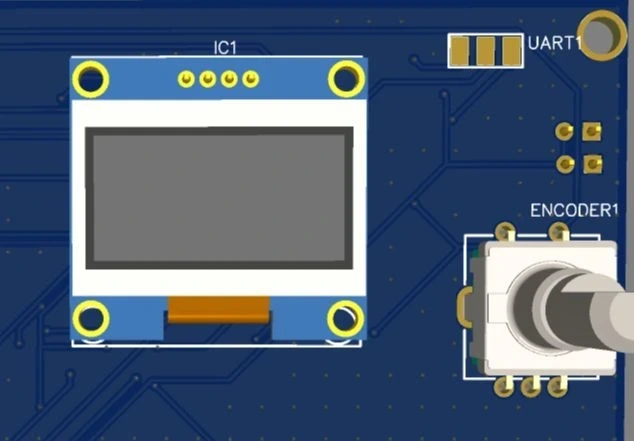 Ongoing
Ongoingusdx-mini.2.6
STDusdx-mini.2.6
License
:GPL 3.0
Description
Project Description: Mini-v2.6 uSDX - Open-Source QRP SDR Transceiver
Introduction
The Mini-v2.6 uSDX is an open-source, low-power (QRP) Software Defined Radio (SDR) transceiver designed for amateur radio enthusiasts seeking a compact, cost-effective, and high-performance solution for High Frequency (HF) communications. Inspired by the innovative work of Guido (PE1NNZ) and Manuel (DL2MAN), with contributions from the global amateur radio community, this project builds upon the uSDX design, an evolution of QRP Labs' QCX. The Mini-v2.6 uSDX combines simplified hardware with advanced digital signal processing, leveraging an Arduino Nano (ATmega328P) microcontroller to deliver a multimode (SSB, CW, and digital modes) transceiver with excellent performance for QSOs in various scenarios, including contests.
The primary goal of the project is to provide an accessible and easy-to-build HF transceiver that balances simplicity, functionality, and performance. The Mini-v2.6 uSDX is ideal for hobbyists, makers, and radio amateurs who wish to explore building modern SDR-based radio equipment while keeping costs low and the design open for customization.
Project Story
The uSDX project originated as a derivative of the QCX, a high-quality CW transceiver developed by QRP Labs. Guido (PE1NNZ) introduced a groundbreaking approach by shifting much of the hardware complexity to software, using the ATmega328P microcontroller to implement SSB signal generation through Digital Signal Processing (DSP) techniques. Subsequently, Manuel (DL2MAN) enhanced the design with an optimized PCB layout and a Class-E power amplifier, making the uSDX more efficient and accessible to the community. The Mini-v2.6 uSDX is a compact iteration of this project, designed to operate on three bands (80m, 40m, and 20m) and fit into a small enclosure (110x70x24 mm, available on AliExpress), making it perfect for portable and experimental operations.
The Mini-v2.6 uSDX upholds the open-source ethos, with schematics, firmware, and documentation publicly available, enabling community contributions and adaptations. This project reflects the global collaboration of radio amateurs, with contributions from enthusiasts like Barbaros Aşuroğlu and UD3SBV, who helped refine the design for various configurations and use cases.
Design Ideas
The Mini-v2.6 uSDX design follows a philosophy of hardware simplification, with most processing handled by software. Key design ideas include:
- Hardware Minimalism: The transceiver uses a minimal component count to reduce cost and complexity. The receiver circuit employs a direct-conversion architecture with a high-performance quadrature detector (74HC4053, known as the "Tayloe N7VE detector") for high sensitivity and dynamic range.
- Multimode Flexibility: The Mini-v2.6 uSDX supports SSB (LSB/USB), CW, and digital modes like FT8, enabling versatile operation across different scenarios.
- Compact and Portable: Designed to fit a small enclosure, the transceiver is ideal for portable operations, such as Summits on the Air (SOTA) or field expeditions.
- Open-Source: The entire project, including schematics, firmware, and software, is open-source (CC BY-SA license), encouraging community customization and contributions.
- Energy Efficiency: The Class-E power amplifier and optimized circuits ensure low power consumption, ideal for battery-powered operations.
Features and Functions
The Mini-v2.6 uSDX offers a robust set of features for its category:
Receiver
- Direct-Conversion Architecture: Uses a quadrature detector based on the 74HC4053 IC, delivering high sensitivity, wide dynamic range, and a high third-order intercept point (IP3).
- Dynamic Range: With 10-bit sampling and 4x oversampling, the receiver achieves a theoretical dynamic range of 72 dB in a 2.4 kHz SSB bandwidth.
- RX Attenuators: Built-in attenuators (0 dB, -13 dB, -20 dB, -33 dB, -53 dB, -60 dB, -73 dB) allow dynamic range optimization for various reception conditions.
- Anti-Aliasing Filters: ADC inputs feature low-pass filters (-40 dB/decade at 1.5 kHz) to prevent aliasing and enhance signal quality.
- DSP Features: Includes Automatic Gain Control (AGC), Noise Reduction (NR), and software-controlled attenuation.
Transmitter
- Software-Based SSB Generation: SSB signals are generated digitally by the ATmega328P, eliminating the need for complex analog circuits.
- Transmission Control: Supports VOX (voice-activated transmission), adjustable TX power (TX Drive, typically 4-6), and envelope shaping for optimized modulation.
- Supported Bands: Operates on 80m, 40m, and 20m, with optimized low-pass filters (LPF) for each band.
- Transmission Efficiency: The Class-E amplifier ensures high efficiency, ideal for QRP operations.
Interface and Operation
- Microcontroller: Uses an Arduino Nano with ATmega328P, configured with a 20 MHz crystal for enhanced performance. Programming is supported via USB or ISP.
- Controls: Features a rotary encoder for band selection and adjustments, with support for FT8 operation via a sound card connection.
- Display: Compatible with OLED displays for viewing frequency, mode, and transceiver parameters.
- Digital Modes: Supports FT8 and other digital modes by connecting the audio output to a sound card and adjusting parameters like VOX threshold.
Technical Specifications
- Bands: 80m, 40m, 20m
- Modes: SSB (LSB/USB), CW, digital modes (e.g., FT8)
- Output Power: Adjustable, typically 1-5W (configuration-dependent)
- Power Supply: 12V DC, optimized for low consumption
- PCB Dimensions: Designed for a 110x70x24 mm enclosure
- Microcontroller: ATmega328P (Arduino Nano, modified for 20 MHz)
- License: Attribution-ShareAlike (CC BY-SA)
Build Instructions
The Mini-v2.6 uSDX is designed for ease of assembly, even for beginners. The project consists of several printed circuit boards (PCBs):
- Main Board: Houses the microcontroller, RF circuits, and controls.
- Display and Button Board: Includes the OLED display and interface controls.
- Amplifier and Filter Board: Contains the Class-E amplifier and low-pass filters for the three bands.
- Optional Boards: Front and rear panels for the enclosure (not mandatory).
Schematics and Gerber files are available for fabrication on platforms like PCBWay. Programming the Arduino Nano requires replacing the 16 MHz crystal with a 20 MHz one and removing the associated SMD resistor for the LED. Firmware can be uploaded via the Arduino IDE or an ISP programmer.
Applications
- Amateur Radio: Ideal for SSB, CW, or digital mode QSOs, especially in contests or portable operations.
- Education: A valuable educational tool for learning about SDR, RF, and microcontroller programming.
- DIY and Makers: Perfect for enthusiasts looking to customize and experiment with an open-source transceiver.
Conclusion
The Mini-v2.6 uSDX represents a milestone in QRP transceiver design, blending simplicity, affordability, and performance in a compact package. It embodies the power of open-source collaboration, enabling radio amateurs and hobbyists to build, modify, and enhance a versatile HF transceiver. This project not only provides a practical solution for radio communications but also inspires innovation and learning within the amateur radio community.
For further details, schematics, and firmware, visit the official project repository on GitHub (https://github.com/threeme3/usdx) or the uSDX community forum (https://groups.io/g/ucx).
Design Drawing
 The preview image was not generated, please save it again in the editor.
The preview image was not generated, please save it again in the editor.BOM
 Bom empty
Bom empty Clone
CloneProject Members
 Empty
Empty


Comment